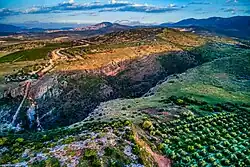Nahal Amud
Nahal Amud (Hebrew: נחל עמוד), also known as the Wadi al-Amud, is a stream in the Upper Galilee region of Israel that flows into the Sea of Galilee.
| Amud | |
|---|---|
 Nahal Amud | |
| Native name | |
| Physical characteristics | |
| Source | |
| • location | Near Kadita, Israel |
| • coordinates | 33°0′46.57″N 35°28′2.87″E |
| • elevation | 816 m (2,677 ft) |
| Mouth | Sea of Galilee |
• location | Ginosar, Israel |
• coordinates | 32°51′11.98″N 35°31′56.9″E |
• elevation | −209 metres (−686 ft) |
| Length | 24.9 km (15.5 mi) |
History

The source of the stream, Ramat Dalton, is located 800 meters above sea level. Its drainage basin includes the peaks of Mount Canaan (955 meters) and Mount Meron (1,204 meters) and flows south through eastern Galilee to the northwest part of the Sea of Galilee – a height of less than 200 meters below sea level.
The stream is named after a pillar that rises high above ground and is located near a channel of the stream near Kibbutz Hukok. The gorge that forms the channel at this point holds many caves once inhabited by Homo heidelbergensis and later by Neanderthal Man such as the cave at Zuttiyeh and the Amud cave. They were the object of the first paleoanthropological excavations in Mandatory Palestine in 1925–1926.[1] The caves contained hominin remains as well as Mousterian and Acheulean artifacts.
Most of Nahal Amud (8923 dunams) was declared a nature reserve in 1972.[2]
Gallery
 Looking north from Nahal Amud lookout
Looking north from Nahal Amud lookout Looking south from Nahal Amud lookout
Looking south from Nahal Amud lookout Water flows from the open Canal of the National Water Carrier of Israel into the inverted siphon in Nahal Amud and to the open canal on the other side
Water flows from the open Canal of the National Water Carrier of Israel into the inverted siphon in Nahal Amud and to the open canal on the other side The inverted siphon in Nahal Amud
The inverted siphon in Nahal Amud
References
- Excavations in the Wadi Amud
- "List of National Parks and Nature Reserves" (PDF) (in Hebrew). Israel Nature and Parks Authority. Archived from the original (PDF) on 2009-10-07. Retrieved 2010-09-27.